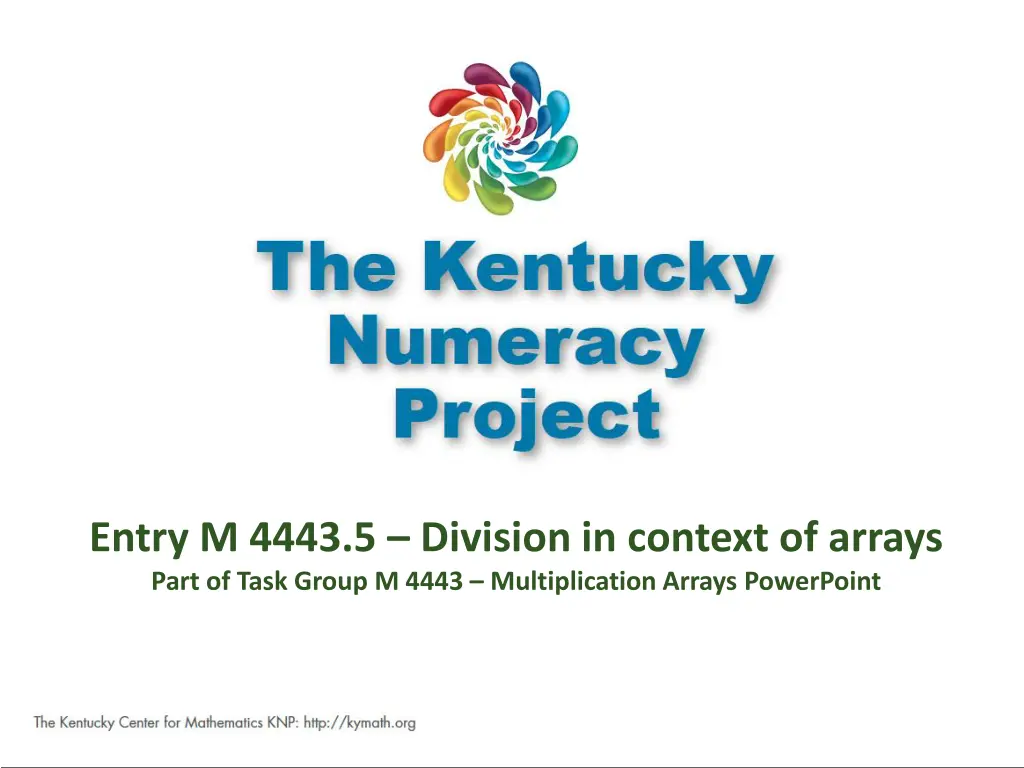
Understanding Array Division in Educational Presentations
Dive into the world of array division through interactive PowerPoint slides. Explore word problems, multiplication sentences, and helpful teacher directions to enhance learning and problem-solving skills.
Download Presentation

Please find below an Image/Link to download the presentation.
The content on the website is provided AS IS for your information and personal use only. It may not be sold, licensed, or shared on other websites without obtaining consent from the author. If you encounter any issues during the download, it is possible that the publisher has removed the file from their server.
You are allowed to download the files provided on this website for personal or commercial use, subject to the condition that they are used lawfully. All files are the property of their respective owners.
The content on the website is provided AS IS for your information and personal use only. It may not be sold, licensed, or shared on other websites without obtaining consent from the author.
E N D
Presentation Transcript
M 4443.5 Entry M 4443.5 Division in context of arrays Part of Task Group M 4443 Multiplication Arrays PowerPoint
M 4443.5 I can solve word problems about arrays and equal groups. I can write the matching multiplication and/or division sentence. Click HERE to skip to first image.
M 4443.5 Connections to CCSS 3.OA.2 Interpret whole-number quotients of whole numbers, e.g., interpret 56 8 as the number of objects in each share when 56 objects are partitioned equally into 8 shares, or as a number of shares when 56 objects are partitioned into equal shares of 8 objects each. 3.OA.3 Use multiplication and division within 100 to solve word problems in situations involving equal groups, arraysand measurement quantities (see Table 2 on next slide for types of word problems.) 3.OA.6 Understand division as an unknown-factor problem. 3.OA.7 Fluently multiply and divide within 100 Click HERE for teacher directions
M 4443.5 Click HERE to skip to first image.
M 4443.5 Teacher Directions Display the word problem. A supportive picture is hidden under the blue box which may be revealed during discussion. Support students problem solving (while supporting picture is screened) with prompts such as What do we know? What do we want to know? If I want to draw a diagram, what information can help me do that? If I want to draw an array, what do I know? What do I need to know? Try creating the array. (Students might use a 10x10 bead rack, dotted popsicle sticks, dotted strips or even counters.) Color or mark the array on array paper. (Students could be given a 10 by 10 empty dot array and color or box in the corresponding array. Click here for pdf of the empty array. The array can be laminated or slipped into a page protector for repeated use. Alternatively, students could be given a large L shaped piece of cardstock to frame the matching array. See examples on the next two slides.) Draw a picture or diagram that will help you figure this out. (A diagram is a simplified drawing of the picture that doesn t involve drawing each individual item. Diagrams are more advanced and more easily extend to larger numbers. See examples on the next two slides.) Click HERE to skip to first image.
M 4443.5 Examples for modeling a 5 x 6 array Pictures (top) 10 x 10 bead rack (right) L shaped screen on a 10 x 10 array grid Click HERE to skip to first image. Click HERE to skip to first image.
M 4443.5 Examples for modeling a 5 x 6 array Pictures clockwise starting top Array marked on a 10 x 10 grid Array with only top row and first column marked Diagram showing rows Diagram showing columns Click HERE to skip to first image.
M 4443.5 Task 1
M 4443.5 If 15 chairs are arranged into 5 rows, how many are in each row? Click ENTER to uncover Click ENTER to uncover
M 4443.5 Task 2
M 4443.5 Mrs. Richards gave 4 candies to each child. If she gave 20 candies, how many children received candies? Click ENTER to uncover Click ENTER to uncover How many groups of 4?
M 4443.5 Task 3
M 4443.5 If 16 cupcakes are shared into 4 groups, how many are in each group? Click ENTER to uncover Click ENTER to uncover
M 4443.5 Task 4
M 4443.5 The grocer packs 18 plums into bags containing 6 plums each. How many bags did the grocer use? Click ENTER to uncover Click ENTER to uncover How many rows of 6?
M 4443.5 Task 5
M 4443.5 If 24 marbles are arranged into 6 equal columns, how many are in each column? Click ENTER to uncover Click ENTER to uncover
M 4443.5 Task 6
M 4443.5 Kathy has 20 pencils. She splits them into groups of 5. How many groups can she make? Click ENTER to uncover Click ENTER to uncover How many rows of 5?
M 4443.5 Task 7
M 4443.5 Sadie gives her 4 friends a total of 12 candies. If the friends share equally, how many candies does each child get? Click ENTER to uncover Click ENTER to uncover
M 4443.5 Task 8
M 4443.5 If 18 dots are arranged into 3 equal rows, how many are in each row? Click ENTER to uncover Click ENTER to uncover
M 4443.5 Task 9
M 4443.5 Will has 30 Pok mon cards. He organizes them into 5 equal rows. How many are in each row? Click ENTER to uncover Click ENTER to uncover
M 4443.5 Extension tasks Task 10
M 4443.5 Caden has 16 cards. He wants to arrange them in an array. What is an array he can make so that no cards are leftover? What is another? Click ENTER to see some examples
M 4443.5 Arrays with 16 cards. 4 x 4 2 x 8 1 x 16
M 4443.5 Arrays with 16 cards. 8 x 2 4 x 4 16 x 1 Also
M 4443.5 Extension tasks Task 11
M 4443.5 Mark has 24 cards. He wants to arrange them in an array. What is an array he can make so that no cards are leftover? What is another? Click ENTER to see some examples
M 4443.5 Arrays with 24 cards. 4 x 6 3 x 8 1 x 24 2 x 12
M 4443.5 Arrays with 24 cards. 6 x 4 24 x 1 8 x 3 12 x 2 Also
M 4443.5 Extension tasks Task 12
M 4443.5 Task 12a: The baker is packaging cupcakes in packages of 12. How many packages can he fill with 60 cupcakes?
M 4443.5 Task 12b: The baker is packaging cupcakes in packages of 12. How many packages can he fill with 50 cupcakes?
M 4443.5 Extension tasks Task 13
M 4443.5 The grocer has 70 apples. (a) If he displays his apples in rows of 10, how many rows will he have? 7 rows of 10 Click ENTER to uncover
M 4443.5 The grocer has 70 apples. (b) If he changes his display so that his apples are in rows of 5, how many rows will he have? Click ENTER to uncover
M 4443.5 The following excerpts come from: Progressions for the Common Core State Standards in Mathematics (draft) The Common Core Standards Writing Team 29 May 2011 This document is available at: http://commoncoretools.me/2011/05/29/complete-draft-progression- for-cc-and-oa/
M 4443.5 Levels in problem representation and solution Multiplication and division problem representations and solution methods can be considered as falling within three levels related to the levels for addition and subtraction (see Appendix). Level 1 is making and counting all of the quantities involved in a multiplication or division. As before, the quantities can be represented by objects or with a diagram, but a diagram affords reflection and sharing when it is drawn on the board and explained by a student. ... 2.OA.4 focuses on using addition to find the total number of objects arranged in rectangular arrays (up to 5 by 5). Level 2 is repeated counting on by a given number, such as for 3: 3; 6; 9; 12; 15; 18; 21; 24; 27; 30. The count-bys give the running total. The number of 3s said is tracked with fingers or a visual or physical (e.g., head bobs) pattern. For 8 x 3, you know the number of 3s and count by 3 until you reach 8 of them. Page 25 main text
M 4443.5 Supporting Level 2 methods with arrays Small arrays (up to 5 x 5) support seeing and beginning to learn the Level 2 count-bys for the first five equal groups of the small numbers 2 through 5 if the running total is written to the right of each row (e.g., 3, 6, 9, 12, 15). Students may write repeated additions and then count by ones without the objects, often emphasizing each last number said for each group. Grade 3 students can be encouraged to move as early as possible from equal grouping or array models that show all of the quantities to similar representations using diagrams that show relationships of numbers because diagrams are faster and less error-prone and support methods at Level 2 and Level 3. Some demonstrations of methods or of properties may need to fall back to initially showing all quantities along with a diagram. (side box page 25)
M 4443.5 Pictures for use in ppt

